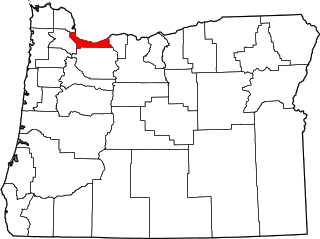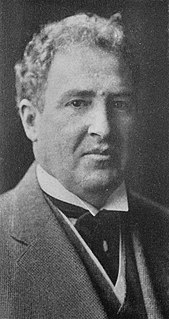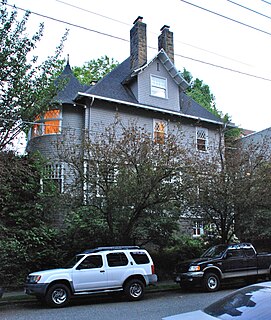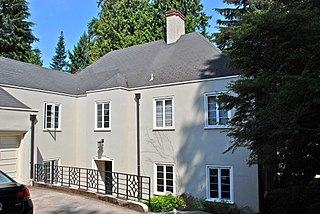
The Pioneer Courthouse is a federal courthouse in Portland, Oregon, United States. Built beginning in 1869, the structure is the oldest federal building in the Pacific Northwest, and the second-oldest west of the Mississippi River. Along with Pioneer Courthouse Square, it serves as the center of downtown Portland. It is also known as the Pioneer Post Office because a popular downtown Portland post office was, until 2005, located inside. The courthouse is one of four primary locations where the United States Court of Appeals for the Ninth Circuit hears oral arguments. It also houses the chambers of the Portland-based judges on the Ninth Circuit.

The following list presents the full set of National Register of Historic Places listings in Multnomah County, Oregon. However, please see separate articles for listings in each of Portland's five quadrants.
Richard Wilhelm Sundeleaf was an American architect from Portland, Oregon, United States. A number of the buildings he designed are listed on the U.S. National Register of Historic Places.

John Virginius Bennes was an American architect who designed numerous buildings throughout the state of Oregon, particularly in Baker City and Portland. In Baker City he did an extensive redesign of the Geiser Grand Hotel, designed several homes, and a now-demolished Elks building. He moved to Portland in 1907 and continued practicing there until 1942.

The Broadway Hotel is a historic hotel building located in Portland, Oregon, built in 1913. As of 2009, it was managed as single room occupancy apartments under the name Helen M. Swindell Apartments. It is listed on the National Register of Historic Places. It was designed by Portland architect John Virginius Bennes's Bennes and Hendricks firm.

Morris Homans Whitehouse was an American architect whose work included the design of the Gus Solomon United States Courthouse in Portland, Oregon.

The Visitors Information Center, also known as the Rose Building, is a historic building located on Naito Parkway in downtown Portland, Oregon, United States. Built in 1948, it is noted as a prominent product of its architect John Yeon. It is listed on the National Register of Historic Places.

The Daniel J. Malarkey House is a historic house located in Portland, Oregon. It was the home of noted legislator and trial lawyer Dan Malarkey (1870–1939) from its construction in 1909 until his death. Associated with Progressive causes, Malarkey presided over the Oregon Senate during its 1913 session, when the legislature passed landmark bills establishing a minimum wage and regulating public utilities. In private legal practice, he played a key part in the ultimately successful battle against the 1922 Oregon School Law.

The Zion Lutheran Church is a church located in downtown Portland, Oregon, listed on the National Register of Historic Places.

The Walter S. Zimmerman House is a historic house located in Portland, Oregon, United States. The Portland architect Wade Hampton Pipes (1877–1961) was the most prominent advocate of the English Arts and Crafts movement in Oregon, and established a wide, exclusively residential, body of work in the English Cottage style during his active career. This 1931 house, designed for the logging and railway businessman Walter Zimmerman, represents a transitional step in the evolution of Pipes's work, moving from traditional stucco walls to brick and adding other Modern details.

The George F. Heusner House is a house located in northwest Portland, Oregon listed on the National Register of Historic Places.

Povey Brothers Studio, also known as Povey Brothers Art Glass Works or Povey Bros. Glass Co., was an American producer of stained glass windows based in Portland, Oregon. The studio was active from 1888 to 1928. As the largest and best known art glass company in Oregon, it produced windows for homes, churches, and commercial buildings throughout the West. When the firm was founded in 1888, it was the only creative window firm in Portland, then a city of 42,000 residents.

The Peter Jeppesen House is a house located in north Portland, Oregon listed on the National Register of Historic Places.

The Maud and Belle Ainsworth House is a historic house located in the Southwest Hills neighborhood of Portland, Oregon. It is listed on the National Register of Historic Places.

The John M. and Elizabeth Bates House No. 1 is a historic house in Portland, Oregon, United States. Architect Wade Pipes, a pivotal figure in the Arts and Crafts movement in Oregon, designed the house in the mid-1930s for his close friends John and Elizabeth Bates. Built in 1935, it represents that decade's transition in Pipes' focus from English vernacular exterior elements toward clean lines, rectilinear forms, and minimal decoration. Its interior spaces and details express his devotion to Arts and Crafts principles. John and Elizabeth Bates subsequently commissioned three further houses from him.

















